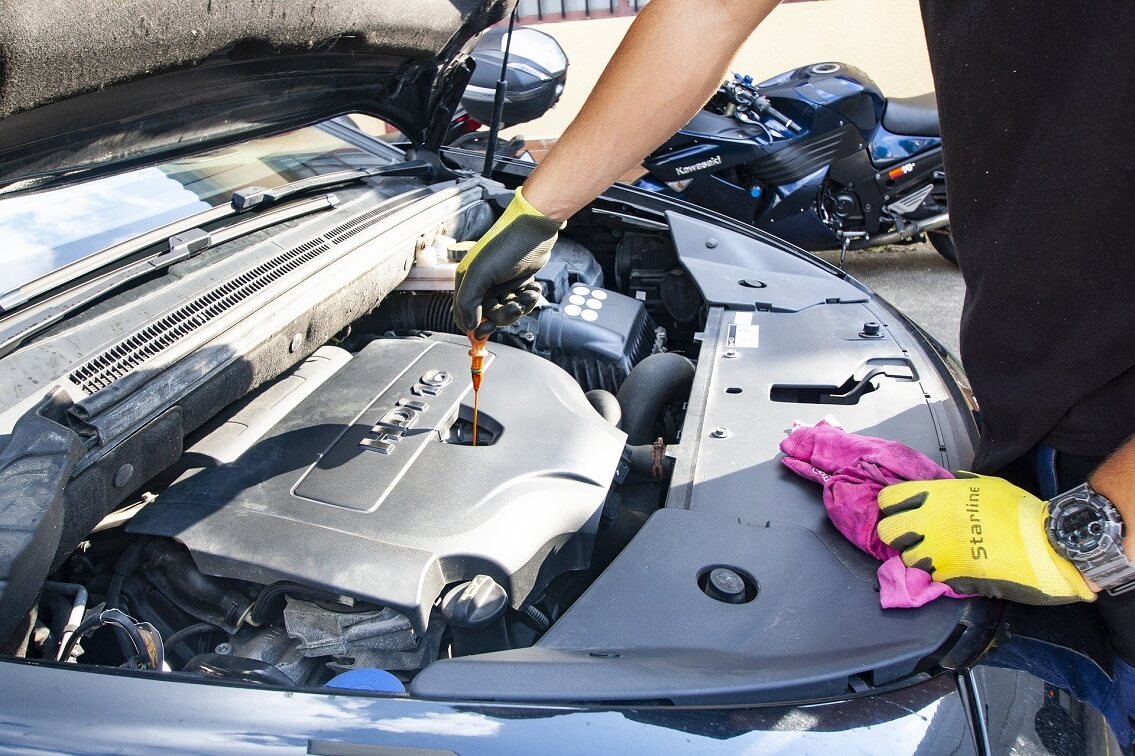
Why liquids leak from the car
Stains under the car are not a good sign. They usually indicate that something is wrong with the car. Therefore, leaking fluids should not be underestimated, because a leak can have unpleasant to dire consequences. In this article we explain why a car leaks and what to do in such a case.

A variety of fluids circulate through every car. Each of them has its own special, clearly defined purpose. Only a few of them can leak. These include:
- Fuels (petrol or diesel)
- Lubricants (engine oil, transmission oil, differential oil)
- Brake fluid
- Coolant
- Condensation water from the air conditioning system
- Air conditioning fluid
- Battery acid
How to identify the stain under your car
In order to find out which part of the car is leaking, it is first necessary to determine which fluid the stain under the vehicle is.
The diagnosis is quite simple thanks to the characteristic properties of the fuels:
Petrol and diesel:
Petrol smells very pungent. It also shimmers like a rainbow when it mixes with water, for example from a puddle.
Diesel, on the other hand, has a slightly oily consistency and a light brown colour.
The cause can be leaking connections, cracked hoses or oxidised fuel filters. The leak may even be the result of a criminal act - someone may have drilled a hole in the car to steal fuel.
The traces can be removed with binder or sawdust. Do not continue to drive with leaking fuel, as this endangers yourself and others. For your own safety, work on fuel lines should only be carried out by professionals.
Lubricants:
Leaking oil can be easily recognised by its brownish or black colour and its greasy consistency. The greasiness can be determined by picking up the oil with the index finger and rubbing it in with the thumb - tip: Use the disposable glove from the first-aid kit for this. Don't forget to refill the glove, otherwise you may be fined at the next inspection!
Oil leaks are often caused by defects in the lines and connected aggregates. But the cause can also be a broken cylinder head gasket, defective seals on valve covers, oil pans or the crankshaft. A fault code analysis of the car could reveal problems with the gearbox.
Because oil must not be allowed to get into the groundwater, blankets and cloths should be laid out to prevent spreading as well as seepage of the oil. If there is even the slightest suspicion that oil has seeped into the ground, the fire brigade should be informed immediately to minimise environmental damage.
Driving on is strictly prohibited, because the car could suffer great damage from the contamination. The same applies to the environment.
These damaged parts could be the cause of the leak: air filter, intake pipes, oil pan and filter, crankshaft, valve cover.
It is advisable to perform an engine wash after repairing the oil leak.
Brake fluid:
The brake fluid is clear brownish or greenish if it is older. It has an oily consistency and a pungent odour. The easiest way to identify it is by where the stain is located. If it is found near the wheel, you can assume there is a leak in the brake system.
If the hydraulic fluid boils over and runs out of the expansion tank, then a puddle of brake fluid will form under the car. This happens with very old fluid that has drawn water. In older cars, rusted lines or leaking hoses could also be the trigger for overflowing brake fluid. Defective dust boots on the brake pistons can also be responsible.
Brake fluid should be disposed of with oil binding agent in the hazardous waste. It is not advisable to continue driving, as further damage can be caused when coupling and braking with too little brake fluid in the system. The repair should be carried out by a workshop because the entire brake system must be bled afterwards.
Coolant:
Coolant can be recognised by its slightly sweet smell due to its glycol content. It is only very slightly greasy, rather liquid like water. Depending on the antifreeze used, the coolant is either greenish, bluish or reddish in colour.
The culprit could be a marten that has chewed on the lines in the car. It could also be a loose hose. The radiator could also have been damaged by small stones or rust. Another place to start could be the V-belt, which, among other things, helps the water pump transport the coolant.
The glycol fluid can be soaked up with sand or similar and disposed of in the hazardous waste. Check the expansion tank when the engine is cold. Possibly top up with coolant to get to the workshop if the cause could not be remedied by yourself.
Condensation water from the air conditioning system:
Condensation from the air conditioning system is nothing more than clear water. Condensation is the only liquid on a car that is allowed to leak. It is produced by the normal operation of the air conditioner and is simply separated.
Climatic agent:
As long as the air conditioning medium in the air conditioner is kept under pressure, it is liquid. However, if the air conditioner has a leak, it escapes in gaseous form. A stain under the car can therefore not come from a defective air conditioning system.
Battery acid:
Because the casing of batteries usually lasts long after the batteries are technically ready for use, battery acid almost never leaks. Theoretically, however, a battery leak is still possible. It is noticeable by its characteristically pungent odour, as is usual with acid. Identifying battery acid is quite easy, as it leaves traces on the battery box when it leaks. In this context, the bottom plate of the battery tray is usually heavily rusted.
If your car should leak in one of our car parks, we will be happy to help you.





